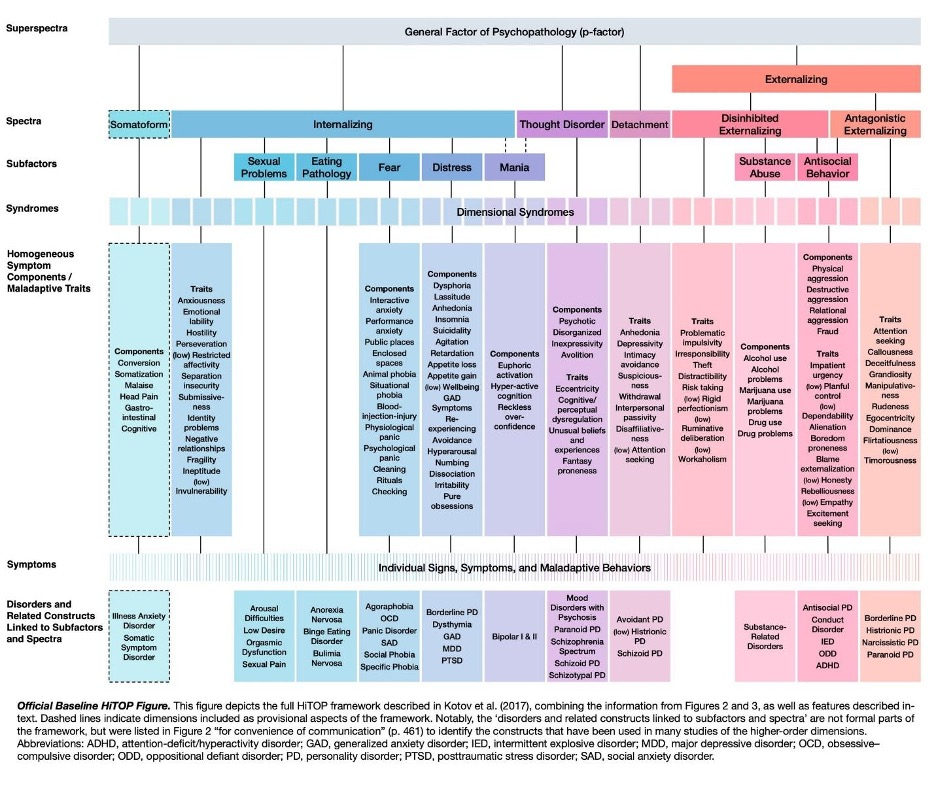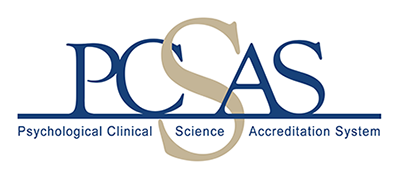by Matt Mattoni
Temple University
As clinical psychologists, we rely on normed structures and classifications of psychopathology for research, therapy, and assessment. The Diagnostic and Statistical Manual of Mental Disorders (DSM) has long dominated the field, despite flaws of arbitrary cutoffs and boundaries, within-disorder heterogeneity, and between-disorder comorbidity. To address classification-related issues such as these, numerous psychologists have been developing an alternative approach to the structure of psychopathology known as the Hierarchical Taxonomy of Psychopathology (HiTOP). I recently interviewed Dr. Aidan Wright, an Associate Professor in Clinical Psychology at the University of Pittsburgh and prominent member of HiTOP, to discuss the new approach. Below, I summarize the highlights of our conversation about HiTOP and how its principles can be incorporated into clinical science training.
What is HiTOP?
Dr. Wright described HiTOP as a multivariate approach to psychopathology classification. It takes fundamental aspects of psychology – psychometrics and factor analysis – to build hierarchical dimensions of psychopathology. In short, HiTOP uses comorbidity between basic clinical indicators such as symptom endorsement to build related syndromes and higher-level dimensions. A working HiTOP model of psychopathology is shown below. However, HiTOP is not a finished model, nor uniformly agreed upon in the consortium; it is constantly evolving based on new research and each member emphasizes different features depending on their diverse perspectives.

A key feature of HiTOP is the five broad spectra of psychopathology that comprise most issues we see in the clinic: Internalizing, Antagonistic Externalizing, Disinhibited Externalizing, Detachment, and Thought Disorder. Dr. Wright sees particular utility in these spectra as they map onto the five dimensions typically found in personality research, providing constructs that represent both function and dysfunction. Above these spectra are higher level factors such as general psychopathology, and below them are more specific syndromes that resemble traditional disorders. In this way, the HiTOP model circumvents arguments about at what level psychopathology should be considered by defining multiple levels simultaneously. A more detailed explanation of the model can be found here, and HiTOP’s website includes a list of relevant publications.
Research Framework, Clinical Tool, or Both?
Dr. Wright stated that while the clinical utility of categorical psychopathology diagnoses can be debated, severe issues arise when these crude measures are used for research, where more specific phenotypes of functioning are necessary. At its core, HiTOP therefore aims to provide a new framework for psychopathology research, where distinct combinations of various dimensions can be used to measure psychopathology more precisely. Examples of recent HiTOP-related research include a comparison between depression diagnosis and internalizing dimensions in mortality prediction and a novel conceptualization of alcohol use disorder.
Additionally, HiTOP has value in the clinic. Dr. Wright recalled a client with an “alphabet soup” of diagnoses including MDD, GAD, SAD, and PTSD. While each of these disorders can be given attention individually, Dr. Wright found utility in discussing the overarching internalizing dimension with the client to provide a destigmatizing explanation about individual differences as well as expectations for treatment goals. In this way, HiTOP can offer an organizing framework of trait-like dimensions, rather than individual diagnoses, that is beneficial to both clinician and client. Dr. Wright also highlighted that there is no tradeoff to using HiTOP as it provides this organizing way of thinking while still being compatible with traditional treatment strategies.
Incorporating HiTOP into Clinical Psychology Training
The organizational framework is one example of how training in HiTOP could be useful for clinical psychology students. On a larger scale, Dr. Wright sees a need for trainees to be pluralistic in their conceptualization of psychopathology. Whether its HiTOP, or other philosophies such as the NIH’s Research Domain Criteria (RDoC), the Unified Protocol, or even psychodynamics, exposure to diverse concepts improves a student’s ability to critically think about their own research questions and draw from multiple sources for versatility in the clinic. Dr. Wright therefore encourages training in diverse philosophies in both formal coursework and research. Still, expertise with the DSM remains necessary as it is the field standard in research, clinic, and education. Dr. Wright ultimately hopes that HiTOP-related perspectives will be included in future manuals and coursework as the field grows beyond a dated reliance on categorical diagnoses.
There are several ways that trainees can become involved in HiTOP themselves. The HiTOP Trainee Listserv provides updates on HiTOP-related research, ongoing projects, and various opportunities, and interested students can email Dr. Timothy Allen to be added to it. The Listserv also functions as a place to identify collaborations, and Dr. Wright noted that there are numerous opportunities for trainee assistance on ongoing projects. Finally, the consortium is developing HiTOP-compatible scales and assessments that they aim to release as free-to-use by the end of 2022. Interested psychologists can visit HiTOP’s Clinical Network for a working list of HiTOP friendly measures that can be incorporated into both research and clinical work.
Overall, HiTOP is a living model that is providing a dimensional, hierarchical classification system of psychopathology. The consortium is relatively new, but rapidly growing and increasing in influence on the field. Trainees can get involved with HiTOP to diversify their own knowledge of psychopathology, assess more precise dimensions of psychopathology in their research, and gain new organizational frameworks to use in the clinic.
Disclaimer: The views and opinions expressed in this newsletter are those of the authors alone and do not necessarily reflect the official policy or position of the Psychological Clinical Science Accreditation System (PCSAS).


